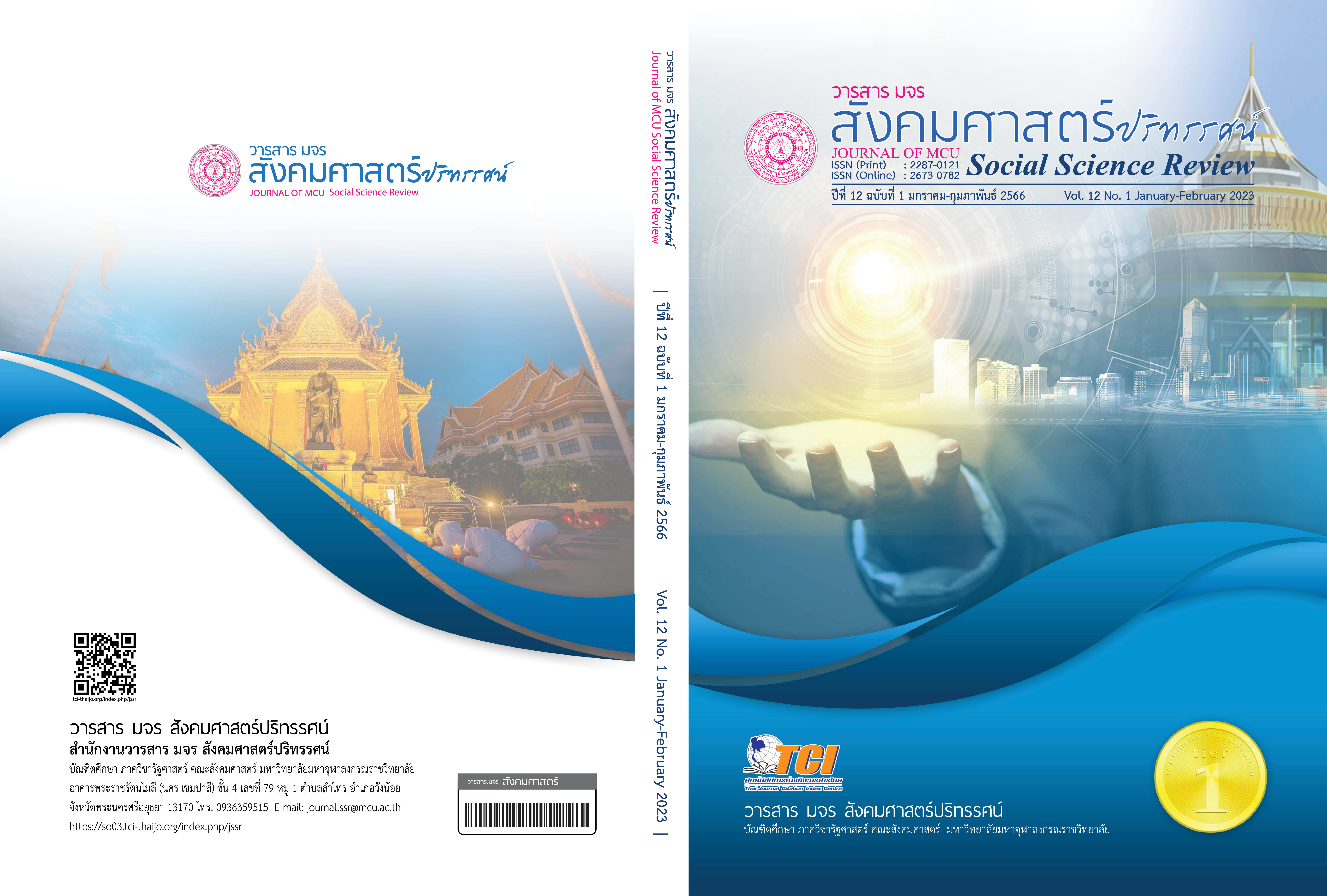กลไกการพัฒนาเครือข่ายทางสังคมเพื่อการปกครองคณะสงฆ์ ที่เข้มแข็งในสังคมไทย
คำสำคัญ:
กลไกการพัฒนา, เครือข่ายทางสังคม, การปกครองคณะสงฆ์บทคัดย่อ
บทความวิจัยนี้มีวัตถุประสงค์เพื่อศึกษาสภาพทั่วไป ศึกษาผลลัพธ์และความคาดหวัง นำเสนอกลไกการพัฒนาเครือข่ายทางสังคมเพื่อการปกครองคณะสงฆ์ เป็นการวิจัยแบบผสมผสานของการวิจัย 3 ประเภท คือ การวิจัยเชิงเอกสาร การวิจัยเชิงคุณภาพ และการวิจัยเชิงปฏิบัติการ
ผลการวิจัยพบว่า 1. เครือข่ายทางสังคมของคณะสงฆ์ที่มีอยู่ในปัจจุบัน ประกอบด้วย ฆราวาส พุทธศาสนิกชน หน่วยงานราชการ องค์กรเอกชน เครือข่ายทางคณะสงฆ์ด้วยกันเอง ซึ่งทุกเครือข่ายช่วยกันทำงานอย่างเหนี่ยวแน่น สนับสนุน อุปถัมภ์กันตามกำลังศรัทธา เน้นการบอกกล่าวกันด้วยวาจา เชิญชวนกันปากต่อปาก จึงส่งผลให้การพัฒนาเครือข่ายมีน้อย 2. เครือข่าย ส่วนใหญ่ยังไม่ประสบความสำเร็จเท่าที่ควร มีบางวัดเท่านั้นที่ใช้เครือข่ายทางสังคมอย่างเป็นประโยชน์ ส่วนความคาดหวังจากเครือข่ายทางสังคม คือ เครือข่ายควรมีการปรึกษาหารือกัน และทำงานกันเป็นทีม 3. กลไกการพัฒนาเครือข่ายทางสังคมเพื่อการปกครองคณะสงฆ์ที่เข้มแข็งในสังคมไทย เริ่มต้นจากทีมนักวิจัยเข้าไปมีบทบาทในการส่งเสริมเครือข่ายทางสังคม ประกอบด้วย คณะสงฆ์จังหวัด สำนักงานพระพุทธศาสนาจังหวัด และสำนักงานยุติธรรมจังหวัด ให้มีบทบาทในการให้คำปรึกษา การให้กำลังใจ การให้ความรู้เกี่ยวกับกฎหมายกับกลุ่มเป้าหมายคือ พระภิกษุสามเณรในพื้นที่ เพื่อลดปัญหาการกระทำความผิดของพระภิกษุสามเณรในพื้นที่ และ สามารถควบคุมพระภิกษุสามเณรให้อยู่ในพระธรรมวินัย และนโยบายของคณะสงฆ์ได้ ส่งผลให้คณะสงฆ์เกิดความเข้มแข็งและยั่งยืนในการปกครอง
เอกสารอ้างอิง
โชติ บดีรัฐ. (2555). การบริหารงานของพระสังฆาธิการ ในเขตการปกครองคณะสงฆ์ภาค 4 เพื่อความมั่นคงแห่งพระพุทธศาสนา (วิทยานิพนธ์ปริญญารัฐประศาสนศาสตรดุษฎีบัณฑิต). ปทุมธานี: มหาวิทยาลัยราชภัฎวไลยอลงกรณ์ฯ.
พระครูพิพิธพัฒนโสภณ (สุบิน สุเมโธ). (2557). รูปแบบการพัฒนาการปกครองคณะสงฆ์ตามหลักอปริหานิยธรรม ในเขตปกครองคณะสงฆ์ภาค 2 (วิทยานิพนธ์ปริญญาพุทธศาสตรดุษฎีบัณฑิต สาขาวิชาการจัดการเชิงพุทธ). พระนครศรีอยุธยา: มหาวิทยาลัยมหาจุฬาลงกรณราชวิทยาลัย.
พระครูสุตธรรมพิทักษ์ (น้ำผึ้ง สุธมฺโม). (2557). การพัฒนาการปกครองคณะสงฆ์ในจังหวัดประจวบคีรีขันธ์ (วิทยานิพนธ์ปริญญาพุทธศาสตรดุษฎีบัณฑิต สาขาวิชาการจัดการเชิงพุทธ). พระนครศรีอยุธยา: มหาวิทยาลัยมหาจุฬาลงกรณราชวิทยาลัย.
พระเทพปริยัติเมธี. (2561). กลยุทธ์การบริหารจัดการองค์กรคณะสงฆ์ ในเชิงกระบวนการและผลสัมฤทธิ์. พระนครศรีอยุธยา: สำนักพิมพ์มหาวิทยาลัยมหาจุฬาลงกรณราชวิทยาลัย.
ดาวน์โหลด
เผยแพร่แล้ว
รูปแบบการอ้างอิง
ฉบับ
ประเภทบทความ
สัญญาอนุญาต
ลิขสิทธิ์ (c) 2023 วารสาร มจร สังคมศาสตร์ปริทรรศน์

อนุญาตภายใต้เงื่อนไข Creative Commons Attribution-NonCommercial-NoDerivatives 4.0 International License.
เพื่อให้เป็นไปตามกฎหมายลิขสิทธิ์ ผู้นิพนธ์ทุกท่านต้องลงลายมือชื่อในแบบฟอร์มใบมอบลิขสิทธิ์บทความให้แก่วารสารฯ พร้อมกับบทความต้นฉบับที่ได้แก้ไขครั้งสุดท้าย นอกจากนี้ ผู้นิพนธ์ทุกท่านต้องยืนยันว่าบทความต้นฉบับที่ส่งมาตีพิมพ์นั้น ได้ส่งมาตีพิมพ์เฉพาะในวารสาร มจร สังคมศาสตร์ปริทรรศน์ เพียงแห่งเดียวเท่านั้น หากมีการใช้ภาพหรือตารางหรือเนื้อหาอื่นๆ ของผู้นิพนธ์อื่นที่ปรากฏในสิ่งตีพิมพ์อื่นมาแล้ว ผู้นิพนธ์ต้องขออนุญาตเจ้าของลิขสิทธิ์ก่อน พร้อมทั้งแสดงหนังสือที่ได้รับการยินยอมต่อบรรณาธิการ ก่อนที่บทความจะได้รับการตีพิมพ์ หากไม่เป็นไปตามข้อกำหนดเบื้องต้น ทางวารสารจะถอดบทความของท่านออกโดยไม่มีข้อยกเว้นใดๆ ทั้งสิ้น





